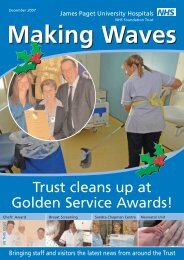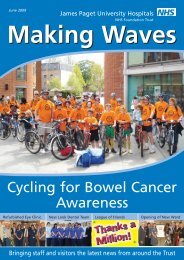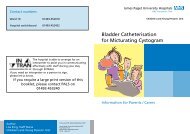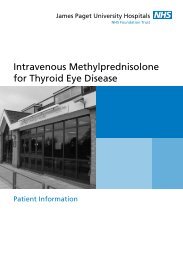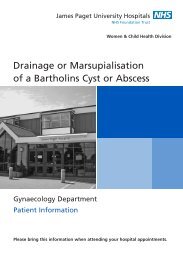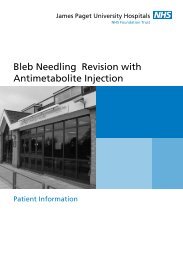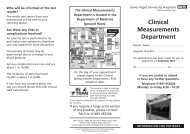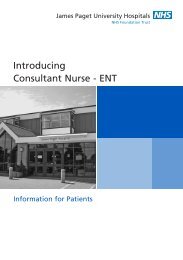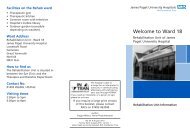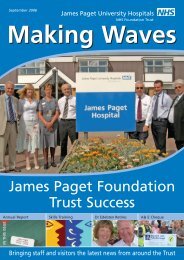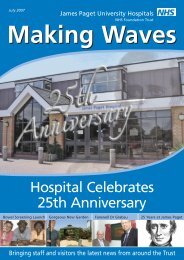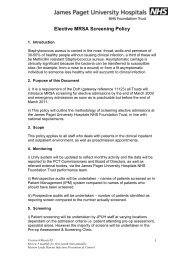Making Waves October 07 - James Paget University Hospitals
Making Waves October 07 - James Paget University Hospitals
Making Waves October 07 - James Paget University Hospitals
Create successful ePaper yourself
Turn your PDF publications into a flip-book with our unique Google optimized e-Paper software.
Inside our Preassessment Clinic<br />
Staff will know that the preassessment clinic prepares patients for admission to surgery, as<br />
. inpatients or day cases. Patients normally have an appointment with a preassessment nurse<br />
one to two weeks before their operation. But what does the clinic achieve, and how? Here,<br />
Michael Lundberg Consultant Anaesthetist, Michelle Thompson, Preassessment Sister and<br />
Donna Carrier, Anaesthetic Administrator explain all. They recently made the semi-finals in an<br />
Eastern region Health Care Innovation Contest, and wanted to share what we told them with<br />
<strong>Making</strong> <strong>Waves</strong> readers.<br />
Left: The Preassessment Clinic team: left to right: Michael<br />
Lundberg, Consultant Anaesthetist; Debbie Norton, Staff<br />
Nurse; Sharon O’Connor, Sister; Irene Spencer, Admissions<br />
Coordinator and Michelle Thompson, Senior Sister.<br />
So what does Preassessment Do?<br />
The prospect of having even minor surgery can stir up<br />
considerable anxiety in a patient. A good psychological<br />
preparation is essential and has been shown to speed up<br />
recovery. Thus a lot of information is given to clarify what lies<br />
ahead, and ample time is allowed for questions. Many patients<br />
also need bloods taken, X-rays or ECGs done and medications<br />
stopped or modified. The Kardex and other paperwork are<br />
initiated to facilitate the admission process and pre-clerking (ie<br />
examination by a junior doctor) is frequently done at this point.<br />
One of our most important tasks is to identify the patients<br />
at risk of developing complications during or after the<br />
operation. Due to other illnesses patients may lack the<br />
functional reserves to meet the stress imposed by major surgery<br />
which has been compared to running half a marathon. Function<br />
of key organs can be so compromised that anaesthesia is<br />
hazardous. It is essential that these patients are thoroughly<br />
investigated before the operation so that specific risks can be<br />
identified and precautions taken. Such a patient may need<br />
specially tailored anaesthetic technique, monitoring and organ<br />
function support both during and after the operation. They will<br />
also benefit from close monitoring in the high dependency unit<br />
(HDU) for a time after the operation. Studies have shown a clear<br />
decrease in complications if patient risk factors are properly<br />
managed. Fewer complications translate directly into shorter<br />
length of stay and a higher patient turnover.<br />
High-risk patients are traditionally picked up by surgeons.<br />
They communicate with their anaesthetist who then initiate an<br />
investigation of the patient. Some patients slip through the net,<br />
however. When the patient is seen at preassessment one to two<br />
weeks before admission it’s often too late to address serious<br />
health problems and the operation has to be deferred.<br />
Occasionally, these patients are only picked up after admission<br />
and promptly cancelled by the anaesthetist. The patient is<br />
distressed, the surgeon occasionally upset, bed and theatre list<br />
management poor, and the result is sub-optimal use of hospital<br />
resources.<br />
4 <strong>October</strong> 20<strong>07</strong> <strong>Making</strong> <strong>Waves</strong><br />
All about the Well Being Questionnaire (WBQ)<br />
In 2004 Dr Frayssinet (then a JPUH Consultant Anaesthetist)<br />
developed a system to address these short term cancellations.<br />
On decision to operate the patient is asked to fill out a health<br />
questionnaire (WBQ) designed to flag up health problems and<br />
given a slot on the waiting list. A preassessment nurse uses<br />
information from the WBQ to risk grade the patient. BMI (body<br />
mass index), general health score, exercise tolerance and type of<br />
surgery (minor/ intermediate/major) make up a risk index.<br />
Patients who are fit or have well controlled systemic disease<br />
have telephone preassessment or an appointment with a<br />
preassessment nurse. Patients with a high risk score have their<br />
notes reviewed by a consultant anaesthetist, who decides if they<br />
need a clinic appointment or further investigations and plans<br />
the level of postoperative care. No patient has their waiting list<br />
number activated unless they have been “green-lighted” by<br />
dedicated preassessment staff or an anaesthetist.<br />
The gains of the system are that resources are focused on the<br />
high risk patients, who need them most. Waiting time is used to<br />
identify and if possible optimise treatment of co-existing illness<br />
that might affect surgical outcome. Unless exceptional measures<br />
are necessary (such as coronary interventions) no patient loses<br />
their original place on the waiting list.<br />
The WBQ system was launched as a pilot covering general<br />
surgical and urological patients in January 2005. It quickly<br />
proved its worth, as showed by an audit of the first six months<br />
running: short term cancellations for major medical problems<br />
had ceased to be a problem. Gynaecology joined the system<br />
from April 20<strong>07</strong>.<br />
Part of the<br />
Anaesthetic<br />
administrative<br />
team:<br />
Donna Carrier,<br />
Anaesthetic<br />
Administrator<br />
and Sharon<br />
Peek,<br />
Anaesthetic<br />
WBQ<br />
secretary.<br />
www.jpaget.nhs.uk



